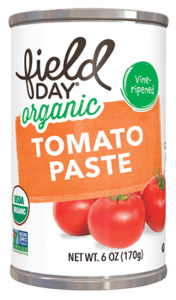Creative Use of Tomato Paste

By Chef Nancy Berkoff, EdD, RD
A good-quality tomato paste is a bit of summer sunshine in a can or a tube, just perfect for this cold time of year. Tomato paste is the concentrated essence of cooked tomatoes, period. When purchasing tomato paste, be certain that the main (and hopefully only) ingredient is tomato; a very small amount of salt or citric acid may be added, but is usually not necessary.
Tomato paste is used to thicken and enhance the flavor and color of sauces, pasta fillings, salad dressings, soups, stews, chili, or in any items where you’d like the tomato flavor to stand out. You can coat sliced vegetables (such as potatoes, parsnips, plantains, or mushrooms) with tomato paste and bake or grill to create a tangy crust. Friends of ours use tomato paste as a sandwich spread, instead of ketchup. Use it sparingly, however, because tomato paste has an intense flavor. If you are using only a portion of a can of tomato paste remember to store the remainder in plastic or glass, never metal, and never, ever in the can (no, we have not been peeking into your refrigerator). If you like, you can freeze properly-stored tomato paste until it is needed.
To make tomato paste, ripe tomatoes are first cooked for several hours to reduce moisture, are strained to remove the seeds and skin, and then are cooked further to reduce them to a thick, rich concentrate. Yes, you could try this at home, but you’d need lots and lots of tomatoes, pots that are not made of aluminum or copper (cast iron is best), and lots and lots of time.
Ever wondered what the difference is between tomato purée and tomato paste? We’re glad you asked! Tomato purée consists of tomatoes that have been cooked briefly and strained, resulting in a thick liquid with a consistency between tomato paste and crushed tomatoes. Tomato paste goes a step further, attempting to remove as much moisture as possible, capturing the tomato “essence.”
Two tablespoons of tomato paste has only 30 calories with no fat and about 20 milligrams of sodium, a bit of fiber, some iron and potassium, and some Vitamin C and A. Tomato paste, and all tomato products, contains lycopene, a naturally-occurring plant chemical said to help reduce the incidence of certain cancers and cardiac conditions.
Tomato paste is indispensable in any kitchen. You can use it in soups and stews, casseroles and roasted grains, and as a base for pasta and pizza sauces. Create toaster-oven pizza with bagels or English muffins topped with tomato paste, your favorite pizza flavorings (oregano, garlic, basil, etc.), a small spoonful of silken or soft tofu (or vegan cheese), and a sprinkle of nutritional yeast.
